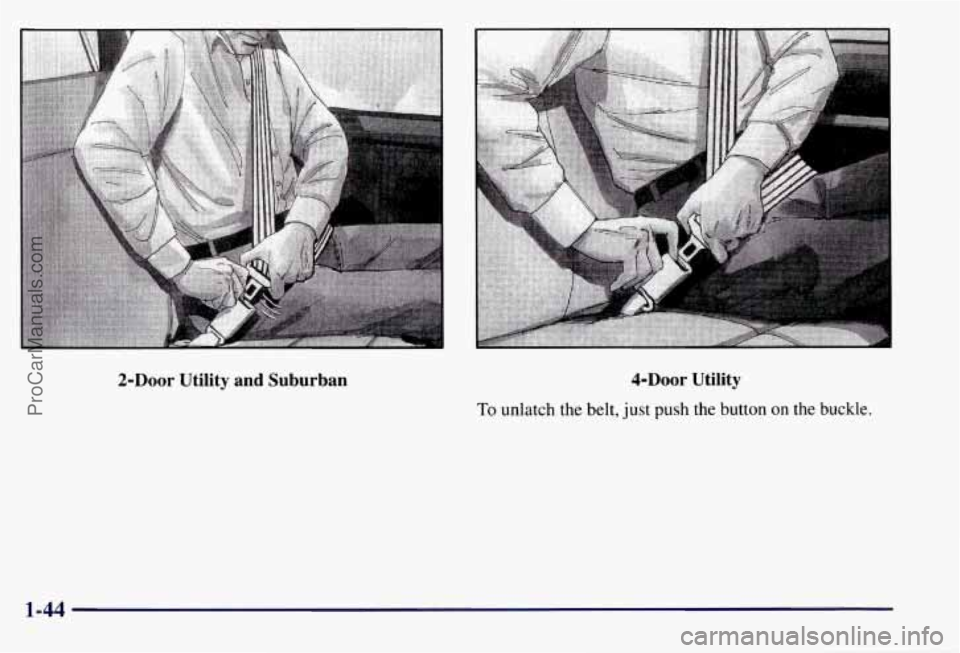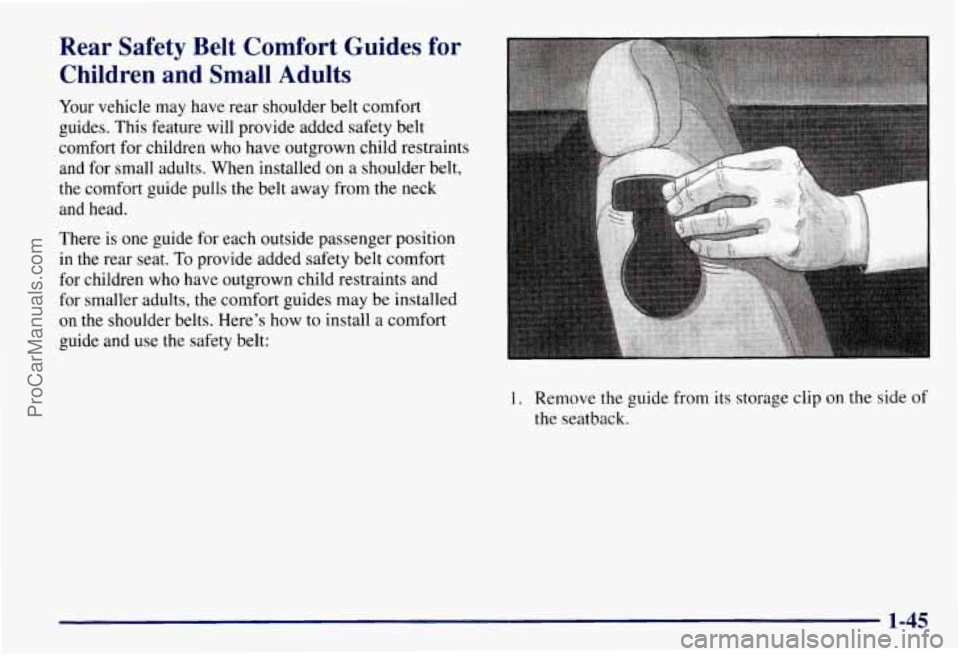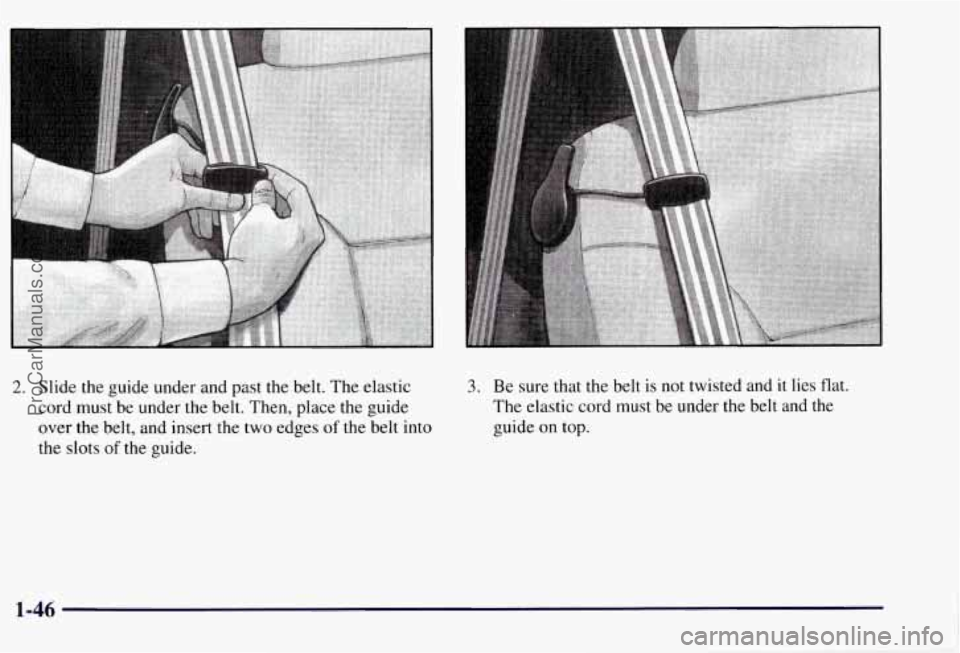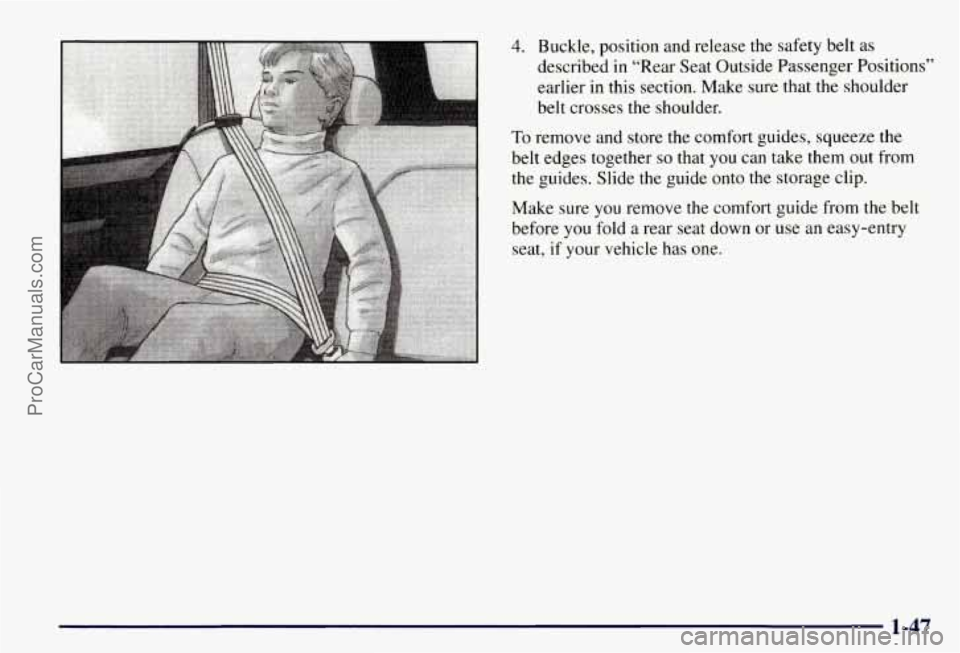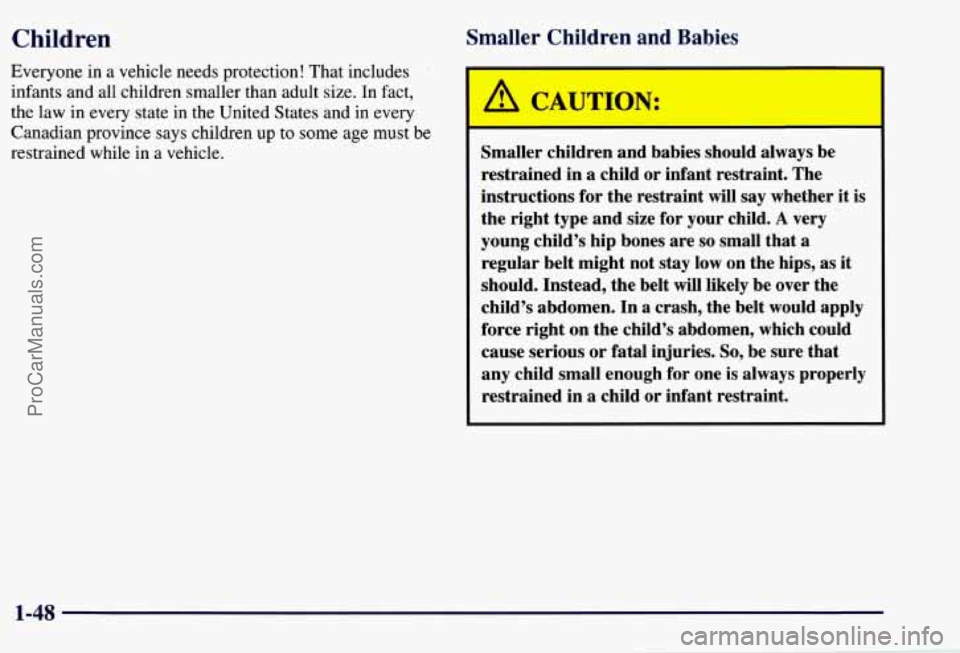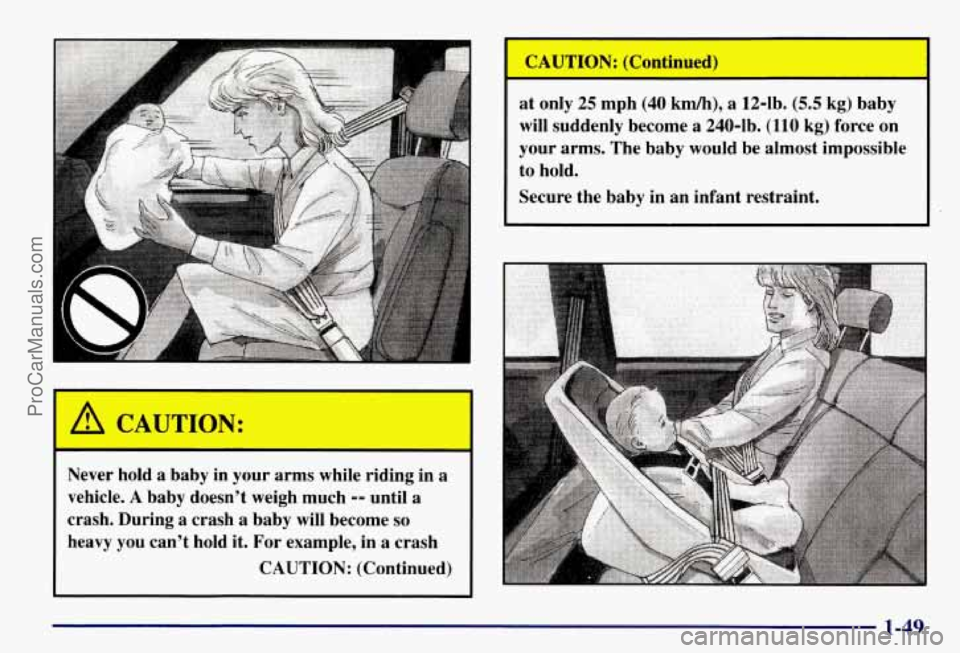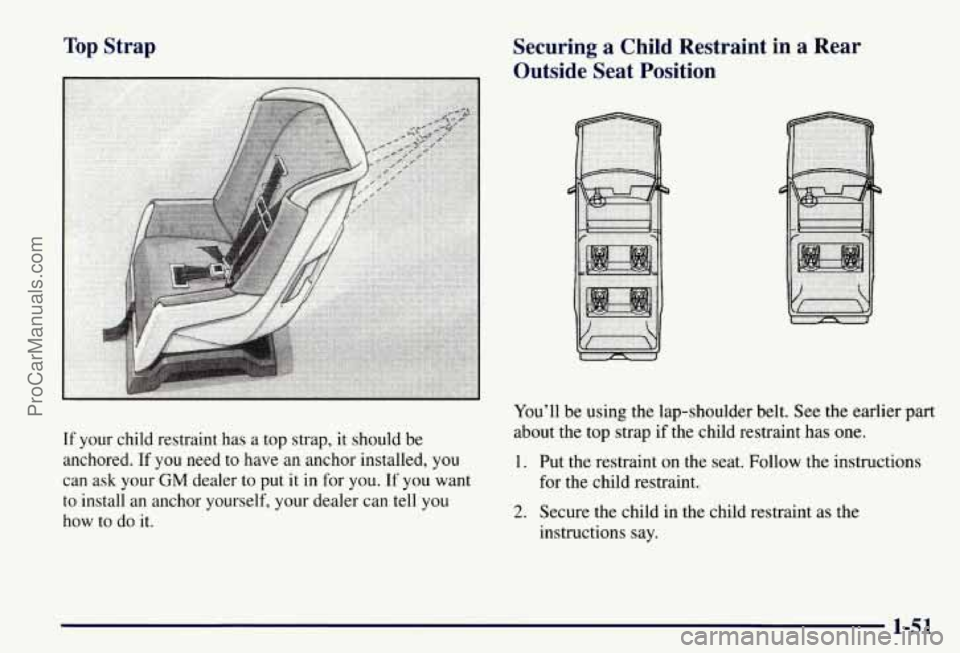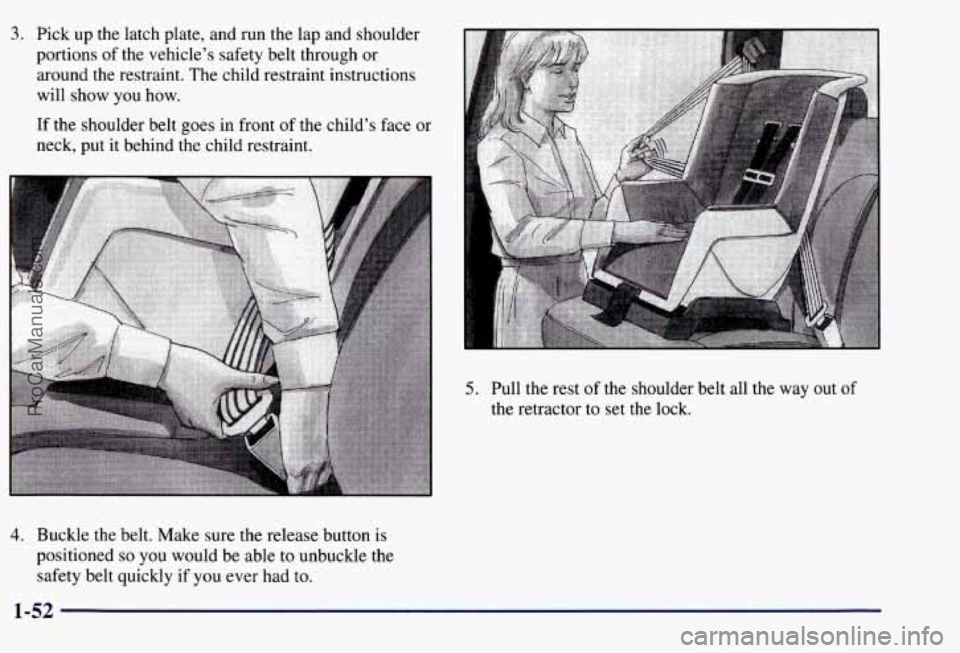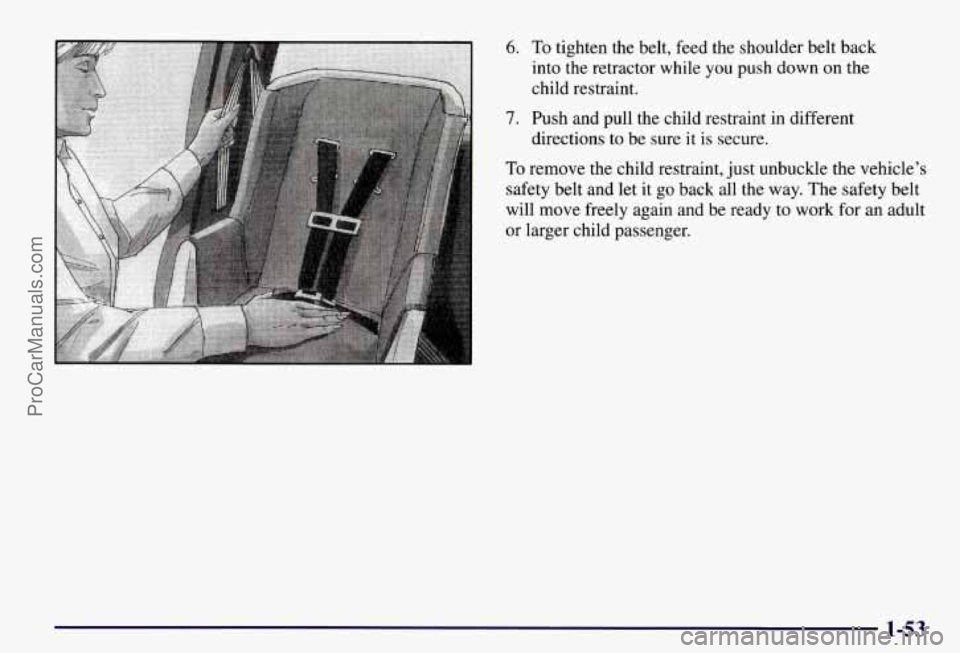CHEVROLET SUBURBAN 1997 Workshop Manual
SUBURBAN 1997
CHEVROLET
CHEVROLET
https://www.carmanualsonline.info/img/24/57717/w960_57717-0.png
CHEVROLET SUBURBAN 1997 Workshop Manual
Trending: low oil pressure, fuel pump, coolant temperature, turn signal bulb, ad blue, fluid, coolant
Page 51 of 433
2-Door Utility and Suburban 4-Door Utility
To unlatch the belt, just push the button on the buckle.
1-44
ProCarManuals.com
Page 52 of 433
Rear Safety Belt Comfort Guides for Children and Small Adults
Your vehicle may have rear shoulder belt comfort
guides. This feature will provide added safety belt
comfort for children who have outgrown child restraints
and for small adults. When installed
on a shoulder belt,
the comfort guide pulls the belt away from the neck
and head.
There is one guide for each outside passenger position
in the rear seat.
To provide added safety belt comfort
for children who have outgrown child restraints and
for smaller adults, the comfort guides may be installed
on the shoulder belts. Here’s how to install a comfort
guide and use the safety belt:
1. Remove the guide from its storage clip on the side of
the seatback.
1-45
ProCarManuals.com
Page 53 of 433
2. Slide the guide under and past the belt. The elastic
cord must be under the belt. Then, place the guide
over
the belt, and insert the two edges of the belt into
the slots
of the guide.
3. Be sure that the belt is not twisted and it lies flat.
The elastic cord must be under the belt and the
guide on top.
1-46
~ ProCarManuals.com
Page 54 of 433
4. Buckle, position and release the safety belt as
described in "Rear Seat Outside Passenger Positions"
earlier in this section. Make sure that the shoulder
belt crosses the shoulder.
To remove and store the comfort guides, squeeze the
belt edges together
so that you can take them out from
the guides. Slide the guide onto the storage clip.
Make sure you remove the comfort guide from the belt
before
you fold a rear seat down or use an easy-entry
seat, if your vehicle has one.
1-47
ProCarManuals.com
Page 55 of 433
Children
Everyone in a vehicle needs protection! That includes
infants and all children smaller than adult size.
In fact,
the law
in every state in the United States and in every
Canadian province says children up to some age must be
restrained while in a vehicle.
Smaller Children and Babies
A CAUTION:
Smaller children and babies should always be
restrained in
a child or infant restraint. The
instructions for the restraint will
say whether it is
the right type and size for your child.
A very
young child’s hip bones are
so small that a
regular belt might not stay low on the hips, as it
should. Instead, the belt will likely be over the
child’s abdomen. In
a crash, the belt would apply
force right on the child’s abdomen, which could
cause serious or fatal injuries.
So, be sure that
any child small enough for one is always properly
restrained in a child or infant restraint.
1-48
ProCarManuals.com
Page 56 of 433
Never hold a baby in your arms while riding in a
vehicle. A baby doesn’t weigh much -- until a
crash. During a crash a baby will become so
heavy you can’t hold it. For example, in a crash
CAUTION: (Continued)
1 CAUTION: (CO-~’----”) I
at only 25 mph (40 km/h), a 12-lb. (5.5 kg) baby
will suddenly become
a 240-lb. (110 kg) force on
your arms. The baby would be almost impossible
to hold.
Secure the baby in an infant restraint.
1-49
ProCarManuals.com
Page 57 of 433
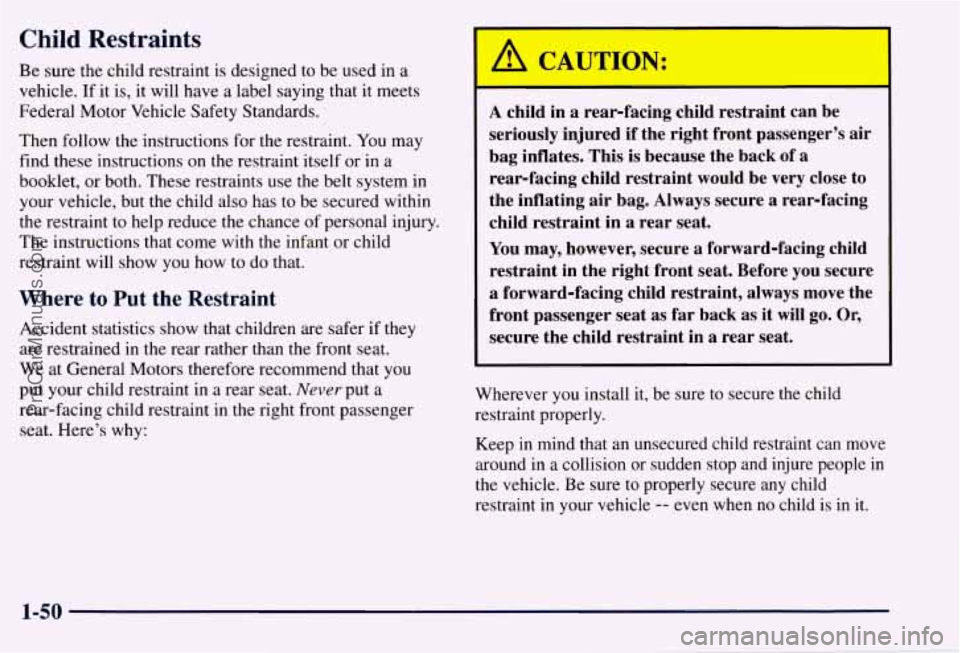
Child Restraints
Be sure the child restraint is designed to be used in a
vehicle. If it is, it will have a label saying that
it meets
Federal Motor Vehicle Safety Standards.
Then follow the instructions for the restraint. You may
find these instructions on the restraint itself or in a
booklet, or both. These restraints use the belt system in
your vehicle, but the child also has to be secured within
the restraint to help reduce the chance
of personal injury.
The instructions that come with the infant or child
restraint will show
you how to do that.
Where to Put the Restraint
Accident statistics show that children are safer if they
are restrained in the rear rather than the front seat.
We at General Motors therefore recommend that you
put your child restraint in a rear seat.
Never put a
rear-facing child restraint in the right front passenger
seat. Here’s why:
A child in a rear-facing child restraint can be
seriously injured if the right front passenger’s air
bag inflates. This is because the back of
a
rearfacing child restraint would be very close to
the inflating air bag. Always secure
a rear-facing
child restraint in
a rear seat.
You may, however, secure a forward-facing child
restraint in the right front seat. Before you secure
1 a forward-facing child restraint, always move the
front passenger seat as far back as it will
go. Or,
secure the child restraint in a rear seat.
Wherever you install it, be sure to secure the child
restraint properly.
Keep in mind that an unsecured child restraint can move
around in a collision or sudden stop and injure people in
the vehicle. Be sure to properly secure any child
restraint in your vehicle
-- even when no child is in it.
1-50
ProCarManuals.com
Page 58 of 433
Top Strap
If your child restraint has a top strap, it should be
anchored.
If you need to have an anchor installed, you
can ask your
GM dealer to put it in for you. If you want
to install an anchor yourself, your dealer can tell
you
how to do it.
Securing a Child Restraint in a Rear
Outside Seat Position
You’ll be using the lap-shoulder belt. See the earlier part
about the top strap if the child restraint has one.
1. Put the restraint on the seat. Follow the instructions
for the child restraint.
2. Secure the child in the child restraint as the
instructions say.
1-51
ProCarManuals.com
Page 59 of 433
3. Pick up the latch plate, and run the lap and shoulder
portions of the vehicle’s safety belt through or
around the restraint. The child restraint instructions
will show you how.
If the shoulder belt goes in front of the child’s face or
neck, put it behind the child restraint.
P
p:
5. Pull the rest of the shoulder belt all the way out of
the retractor to set the lock.
4. Buckle the belt. Make sure the release button is
positioned
so you would be able to unbuckle the
safety belt quickly
if you ever had to.
1-52
ProCarManuals.com
Page 60 of 433
6. To tighten the belt, feed the shoulder belt back
into the retractor while you push down on the
child restraint.
7. Push and pull the child restraint in different
To remove the child restraint, just unbuckle the vehicle’s
safety belt and let it go back
ail the way. The safety belt
will move freely again and be ready to work for an adult
or larger child passenger. directions to be sure it is secure.
1-53
ProCarManuals.com
Trending: jacking, wheel bolt torque, lug pattern, towing capacity, height, park assist, relay
